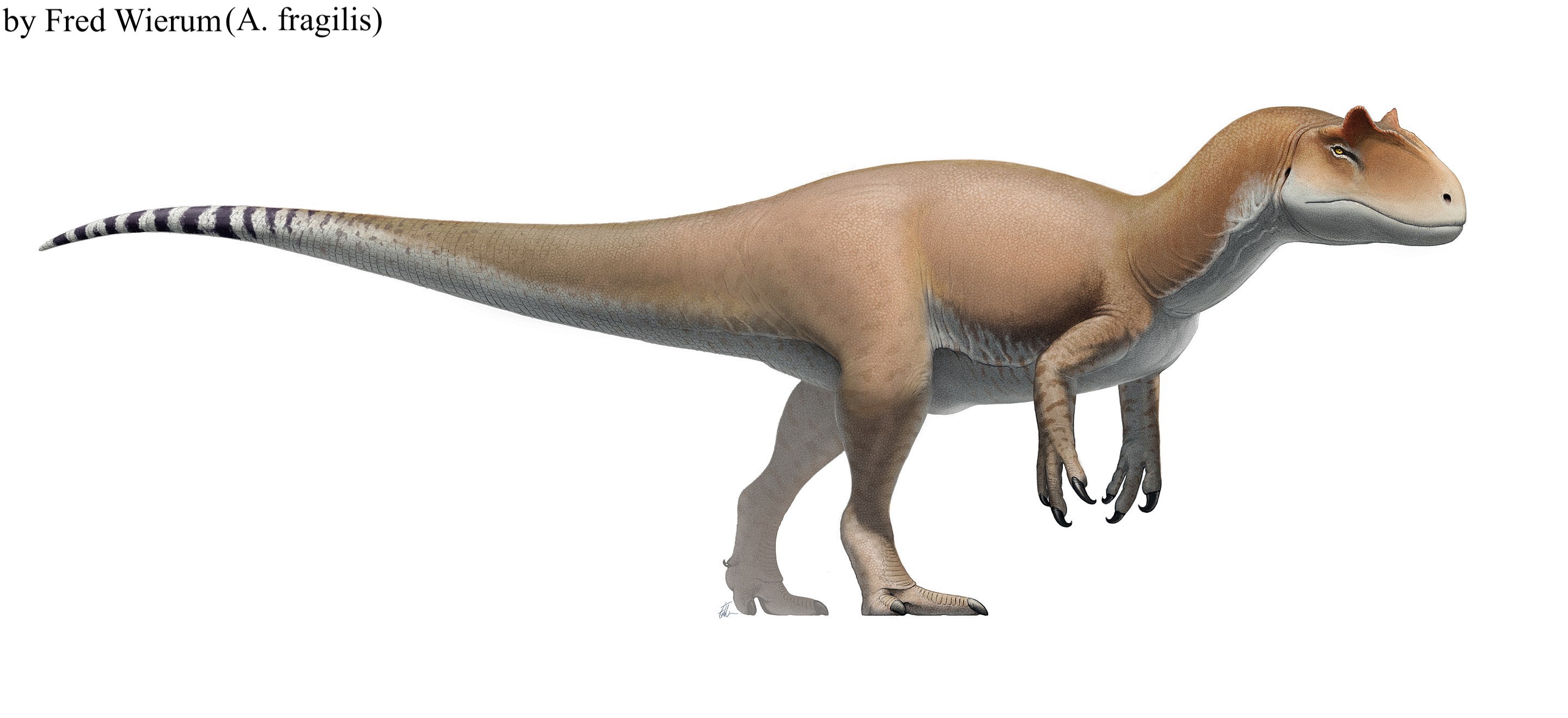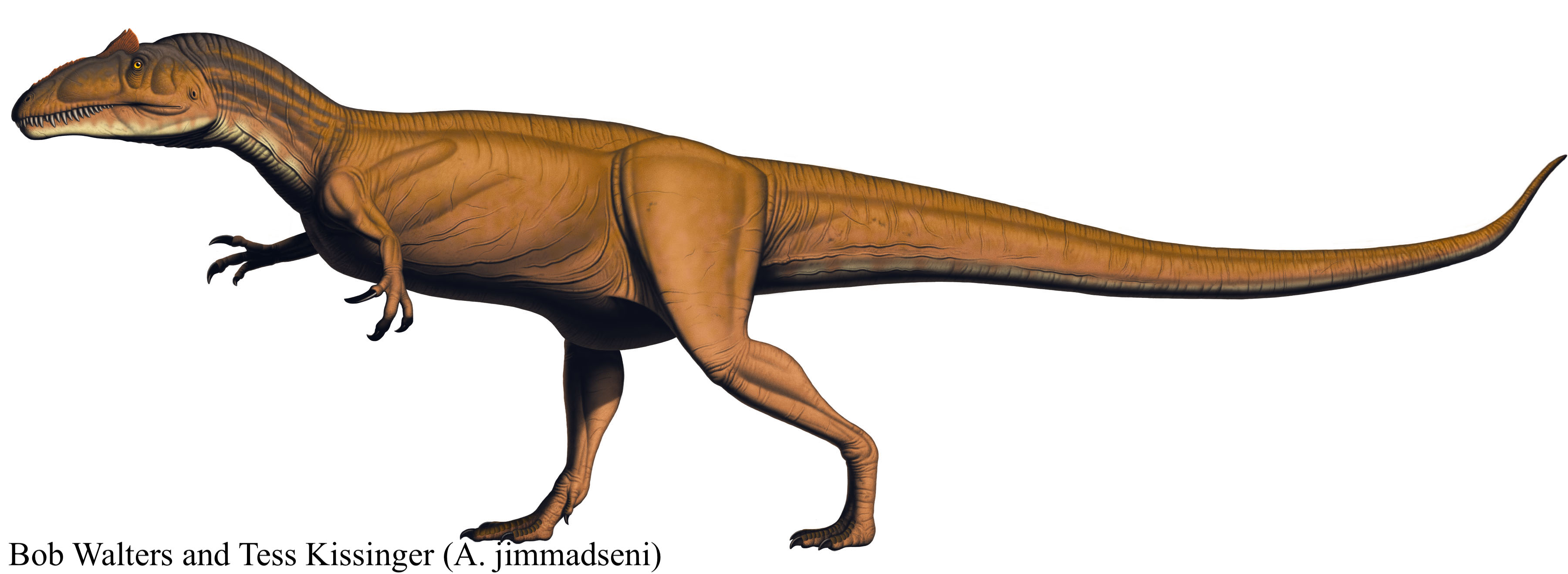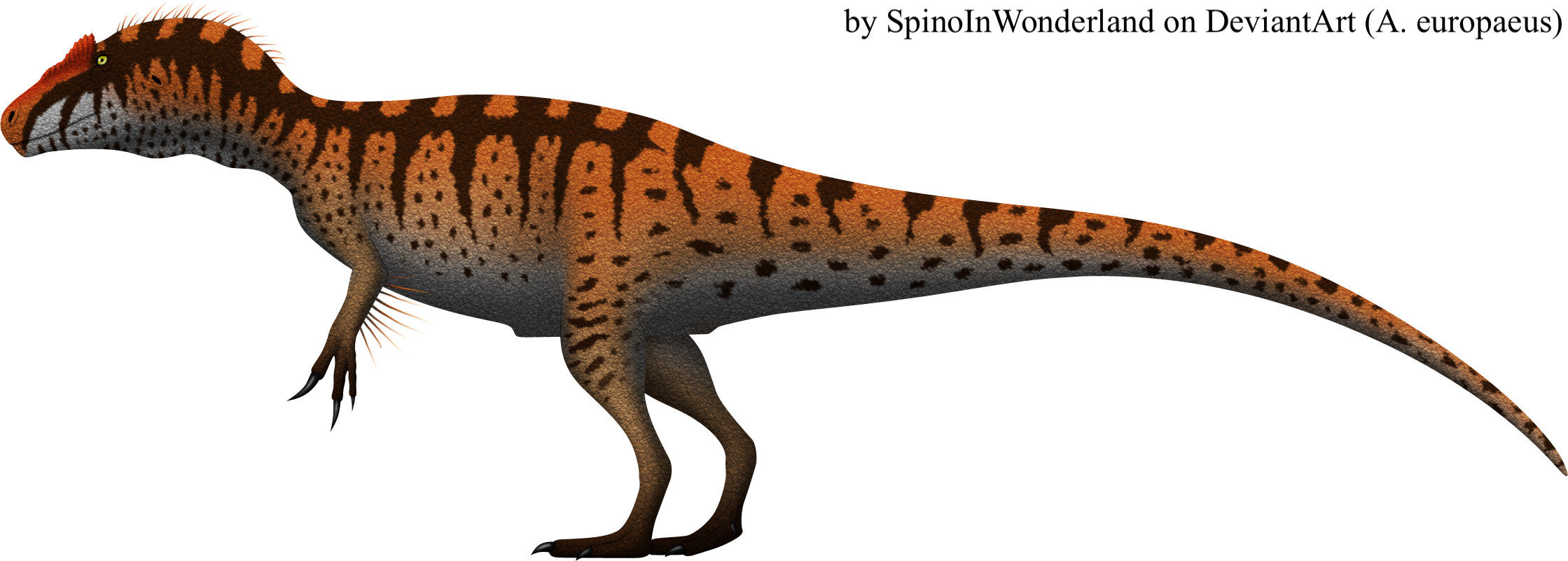Welcome to Allosaurus

Name Definition
Different lizard
Name Given By
Othniel C. Marsh in 1977 (A. fragilis) | Octávio Mateus and colleagues in 2006 (A. europaeus) | Daniel J. Chure and Mark A. Loewen in 2020 (A. jimmadseni)
Location
Morrison Formation and Cleveland Lloyd Dinosaur Quarry in the U.S | Lourinhã Formation in Portugal | possibly the Tendaguru Formation in Tanzania, Africa
Classification
Dinosauria, Saurischia, Theropoda, Tetanurae, Carnosauria, Allosauridae
Size
~ 4 - 5 meters tall and 8 - 12 meters long, 1.5 - 2.2 tons (measurements depend on the species)
Temporal Range
Kimmeridgian - Tithonian of the late Jurassic, ~155 - 145 million years ago
Ecological niche
Apex predator and possibly a social pack hunter
Species/Sub Species
A. fragilis (type species), A. jimmadseni, A. europaeus, ?A. tendagurensis
Diet
being one of the apex predators, Allosaurus would have had the ability to incapacitate a variety of its contemporaries including sauropods, ornithopods, stegosaurids, and even other theropods such as Ceratosaurus
Introduction
Allosaurus is a genus of carnosaurian theropods that lived in the U.S, Portugal, and possibly Tanzania during the late Jurassic. Allosaurus means “Different lizard” in Greek which is in reference to the concave vertebrae being different and unique at the time of its discovery. The species name fragilis is Latin for “fragile” due to the delicate features found in the vertebrae, while “jimmadseni” honors Utah paleontologist James H. Madsen Jr., and “europaeus” references to Allosaurus europaeus being the only species found in Europe. Allosaurus is one of the most well-known dinosaurs in the Jurassic and the Mesozoic in general, being one of the most abundant predators in the Late Jurassic Morrison Formation and the Cleveland Lloyd Dinosaur Quarry with more than 46 A. fragilis specimens being discovered out of less than 73 specimens in there already, making A. fragilis account for 63% of the dinosaur species there. Though it is very famous today, Allosaurus has many synonyms both generic and specific such as Creosaurus, Antrodemus, and Labrosaurus. This was because Allosaurus was discovered during the Bone Wars across North America, one of the largest events in the history of paleontology. This caused the same genus, Allosaurus, to be named under several different genera. Because of this, many of these species from different genera had to be allocated to Allosaurus and also resulted in less synonymous species and genera. However, the classification isn’t over yet, as Allosaurus still has two possible existing synonyms, Saurophaganax and Epanterias, both from the same time and location. While they both are only known from partial remains, they are known to be closely related to Allosaurus. Some scientists believe Epanterias and Saurophaganax are just larger species of Allosaurus, though others believe more research is needed to identify the exact relationship between these three theropods. Allosaurus also has a lot of named species too. While currently there are only the species A. amplus, A. atrox, A. lucasi, A. jimmadseni, A. europaeus, and A. fragilis, Daniel Chure and Mark Loewen (also the two who named A. jimmadseni) recovered only A. fragilis, A. jimmadseni, and A. europaeus as valid species, while the validity of the other species are a controversial topic. Additionally, there is a controversial 7th species of Allosaurus, Allosaurus tendagurensis, from the Tendaguru Formation which it is named after. Its validity is also being debated.
Allosaurus had the typical form of a theropod, with its hind limbs being significantly longer than its forelimbs, and it walked in a horizontal position with its tail stretching out to act as a counterbalance. One of the defining features seen in Allosaurus is the small horns above its eyes, though they are really just extensions of the lacrimal bone which is located on the side of the interior of the eye socket. There are several theories as to how Allosaurus individuals used these crests. One is that they were adaptations to help reduce glare from sunlight, and one of the more widely accepted theories was that it was used to help identify its own species. Another one is the crests being used as weapons like how some horned animals today fight with their horns for dominance. Like all predators, based on the location of the eye sockets in the skull, Allosaurus most likely had binocular vision to focus on its prey, however, it was limited to about 20º of vision, much less than the 120º vision humans have, most likely because predators like Allosaurus had the power to kill larger and slower animals, so they didn’t need such a big field of vision to keep their prey in their line of sight. If its prey did however leave its field of vision, Allosaurus would only be able to turn one eye to the side its prey was on, decreasing the amount of depth perception they would be able to perceive and could result in a miss if it were to strike its prey, and losing depth perception for even the smallest amount of time could greatly benefit the prey in escaping. CT scans of Allosaurus skulls have also revealed much more about Allosaurus than just its eyesight. The brain of Allosaurus was similar to a crocodile, meaning it would have acted more like a crocodile in life. Allosaurus also would have had a very large olfactory bulb (the neural structure in the brain that processes olfactory information from the nose), though it was underused, as Allosaurus only relied on a few scents necessary for its survival such as the smell of prey or its own species. Analysis of the inner ear in Allosaurus shows that it was most likely adapted to low frequencies, and analysis of the vestibular system in the inner ear, which is also responsible for coordinating your movement with balance, shows that Allosaurus held its head horizontally for most of the time. The arms are significantly more robust than most of the theropods in the Cretaceous as they are longer proportionately, and also end in three digits with big claws. Given this arm size, it is most likely that they played a bigger role in the life of an Allosaurus compared to other theropods with shorter arms, though the exact use is still controversial. While these may all be the traits of an adult, it was probably different for juveniles and subadults. Allosaurus juveniles have been shown to have proportionally longer legs than adults, suggesting that they were fast and could have pursued smaller and quicker prey. As its life goes on, Allosaurus would have most likely grown shorter but more robust and stronger legs in order to deal with the stresses of fighting large and slow dinosaurs for its sustenance. Additionally, this kind of early morphology in a theropod’s life has also been seen in the tyrannosaurs like Tyrannosaurus and Albertosaurus, possibly hinting to convergent evolution since they are unrelated, though the reason could also be because of a common ancestor.
Allosaurus has also been speculated to be a scavenger. This mainly comes from the fact that while the head was well developed and strong, studies have shown that Allosaurus might have a bite force weaker than that of a leopard, about 3,572 Newtons. This would mean Allosaurus would have to resort to other strategies in order to efficiently injure its prey. One of the most popular theories is that Allosaurus was a flesh grazer, or a predator that strips off thin pieces of meat from the prey. This is partially due to the wide angle Allosaurus’ jaw could open to, as its weak bite force wouldn’t resist this as much. Allosaurus could have also used this ability to deliver fatal bites that would have killed the prey via blood loss, rather than delivering one crunching bite like the Tyrannosaurus. Another method some people think Allosaurus used is using its head like a tooth-filled hatchet and charging towards its prey, open mouthed, and then clamps onto the prey's neck while its teeth slice and impale the neck without crunching any bone, causing the prey to die of blood loss. Some other evidence that shows Allosaurus was an active predator is one of the fossilized vertebra from an Allosaurus specimen shows a mark from the impact of a Stegosaurus thagomizer, or the tail spikes. There is another Stegosaurus specimen that shows a bite mark from an Allosaurus. This would most likely indicate that Stegosaurus probably made a big part of its diet. Regardless, like most carnivores, Allosaurus wouldn’t pass up the opportunity of a free meal and would have of course scavenged some, and this is backed up by the significant amount of fossil finds that prove scavenging was regular for Allosaurus.
Social interaction between Allosaurus individuals is also being discussed. Due to the large number of Allosaurus individuals that make up most of the predators in the Cleveland Lloyd Dinosaur Quarry, it is thought that Allosaurus was a pack hunter. Although it was one of the apex predators in its environment, it is clear that Allosaurus wasn’t capable of hunting some of the large adult sauropods by itself. One possible way Allosaurus packs took down large sauropods is what is termed “mobbing behavior” where instead of using strategy, a pack would repeatedly attack a prey animal and weaken it until it would die of exhaustion and wounds. This behavior has been seen in some bird species, which makes sense since birds are direct descendants of dinosaurs so it is evident that they would have some same behaviors. There is some more evidence that Allosaurus was social. Even if they weren't pack hunters, Allosaurus may still have been social, since the neurocranial analysis revealed that Allosaurus had a brain similar to the modern day crocodile, which would suggest Allosaurus acted more like crocodiles rather than birds. Crocodiles today aren't pack hunters, but they are some of the most social reptiles and will usually congregate in social groups formed in rivers. They will usually tolerate each other during feeding and basking, but when mating season comes, males turn against each other to win a mate, and this might have also occurred in Allosaurus social groups. However, some are not convinced that these Allosaurus fossils are together because of social activity, but because of either aggressive behavior or a group of random individuals sharing a carcass. But, when it comes to the truth of these topics, it all comes down to the fossil evidence we have, so if we want to prove or learn anything new, more discoveries will have to be made.

